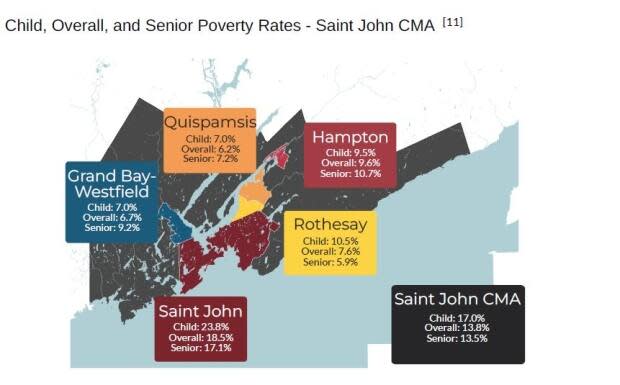Pandemic supports led to drop in N.B. child poverty rate, report says

The child poverty rate in New Brunswick decreased by about five per cent during the first year of the COVID-19 pandemic — but that was driven by federal income supports that are no longer available, according to a new report.
The annual report from the Saint John-based Human Development Council found the child poverty rate decreased from 21.7 per cent in 2019 to 16.6 per cent in 2020.
"It is a notable decrease. But we explicitly say that it's not cause for celebration yet," said Chelsea Driscoll, a researcher with the council who worked on the report.

The data for 2021 and 2022 isn't yet available, but Driscoll said without the supports, the picture likely isn't good.
"Families are grappling with increased inflation. Food and housing and gasoline prices are more than they were in 2020," Driscoll said.
"So it's really easy to see a situation where things are either, you know, back to pre-pandemic states, or potentially even a little bit worse."
Drop shows power of financial support
The drop in 2020 provides a case study of how significant a role government financial transfers can play in reducing child poverty, Driscoll said.
"This is definitely one avenue that government could explore to further child poverty reduction efforts," she said.
One of several recommendations in the report calls on the federal government to invest $6.4 billion in a new financial transfer that would be targeted toward families in deep poverty.
The report is being studied and its recommendations are being reviewed, said Mohammad Hussain, spokesperson for the federal minister of families, children and social development.

"Insights such as those contained in this report are invaluable when it comes to charting the path ahead," Hussain said in a statement.
Hussain referenced the government's recent work on child poverty, such as the Canada Child Benefit. Driscoll noted the benefit has been a "key player" in reducing child poverty.
The release is part of a nationwide project called Campaign 2000: End Child and Family Poverty, which is made up of a coalition of organizations. The Human Development Council is the provincial partner for New Brunswick.
Poverty rate for racialized children in N.B. double national percentage
At 30.7 per cent, the poverty rate for racialized children in New Brunswick is double the national rate, according to the report.
The reason for this is structural and systemic racism, the report said.
"These refer to racial discrimination that is pervasive and deeply embedded within systems, laws, policies, and programs," the report states.
Additionally, one in four Indigenous children in New Brunswick live in poverty, according to the report.
"The lasting effects of colonialism, racism and intergenerational trauma exacerbate child poverty for Indigenous children," according to the report.

The report also found that Campbellton, Bathurst and Saint John have the highest rate of child poverty in the province.
In Saint John in particular, the report shows the child poverty rate is higher in the city than its neighbouring suburbs. The rate was 23.8 per cent in Saint John and seven per cent in Quispamsis.
Report calls for CERB repayment amnesty
The pandemic income supports lifted 10,300 children in New Brunswick out of poverty, Driscoll said.
But since 2020, some families have been asked to pay back some of that money, she said.
The report calls on the federal government to give families below or near the poverty line amnesty on CERB repayments.
"Providing a CERB amnesty to families that are living below or near the poverty line would be a very impactful policy change," Driscoll said.
The report found that without income supports, the child poverty rate would have been about seven per cent higher in 2020.
"You're taking a transfer that we know already makes a huge difference. And you're cutting that for families. There's no way that that doesn't have a ripple effect," Driscoll said.


